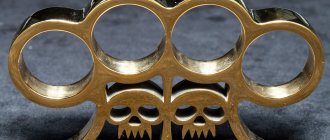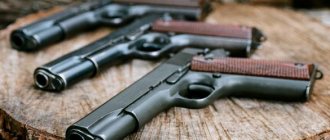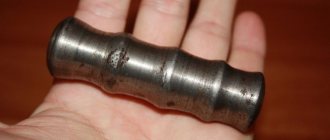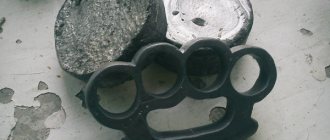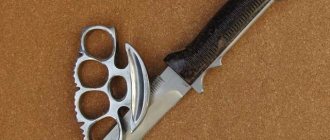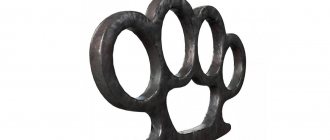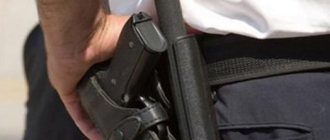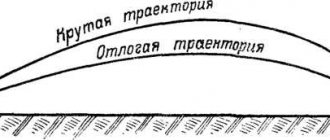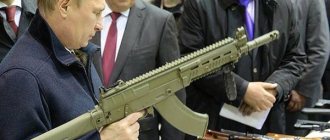Brass knuckles (from the French Casse-tête - “to break heads”, called “puzzle”) is considered a cold weapon with a shock-crushing effect, clamped with the hand before striking. Brass knuckles can be made in factory, homemade or homemade ways. They can be metal, plastic, wood, plexiglass or other materials. In essence, it is a plate with holes for fingers.
Brass knuckles
Brass knuckles are a favorite weapon, most often used by writers and hooligans, scientists and soldiers. Historians considered them to be street and gang weapons. Museums are not filled with brass knuckles, there are almost no scientific works on this topic, although brass knuckles have a long history and fully deserve places in weapons museums.
Brass knuckles were first mentioned as gladiator weapons in the 2nd AD. Roman historians describe the “Bronze Fist” - a bronze plate with holes for fingers, clamped by a fighter’s fist. For a long time, historians believed that this was a “cestus” - a belt reinforced with bronze plates that wrapped the fists of ancient boxers, until in the 1920s, during excavations of the Lyon circus, bronze brass knuckles were found corresponding to the ancient descriptions.
The next mention of brass knuckles belonged to Venetian sailors of the 15th-16th centuries. In boarding battles in the cramped ship cabins, hilts were often used to strike. And then the guards of the sabers were strengthened with the help of spikes. What came out was a certain combination of blades and brass knuckles.
At the same time, something like brass knuckles became popular among the Indians, Japanese and Chinese. These were different types of brass knuckles, such as the Chinese “fighting rings”, “fighting combs”, etc. The Indians, in addition to iron, had brass knuckles made of wood, horns, etc. Maori brass knuckles made of wood were reinforced with obsidian stakes or shark teeth.
For the first time in Europe, brass knuckles were mentioned in 1819. Thus, American captain Jack Peterson described a fight in the port of Marseille in which two of his sailors were killed. He was surprised at the effectiveness of the brass knuckles used by the French sailors, and suggested equipping the American ones with them. According to the description, the brass knuckles had a T-shaped palm rest and consisted of three soldered brass rings. "Cap" dubbed him "Brass Knuckles", which has become entrenched in the English language to this day.
History of brass knuckles
The “progenitor” of brass knuckles were cestus – leather strips wound on the hands of Roman gladiators. Their task was to increase the damage when striking, for which purpose metal plates were subsequently sewn into the skin.
Brass knuckles are made both by handicraft and factory methods. During handicraft production, lead is mainly used as a material for these weapons. The advantage of lead is that it melts easily, hardens and does not require any technological excesses during the manufacturing process. However, the downside is that lead is a very soft metal, and once made from it, brass knuckles can “collapse” upon impact, leaving the owner with broken fingers. Factory production involves the use of more durable alloys and, as a result, greater reliability and durability during use.
Brass knuckles were one of the favorite weapons of the Italian mafia in the 1930s, along with baseball bats and stilettos. Simple and effective, it helped achieve its goal, be it attacking opponents, torturing people, or defense. In the second season of The Invincible Warrior, which compared the gangs of Jesse James and Al Capone, tests were carried out on the force of a blow with brass knuckles on a human skull. It only took one blow to fracture the skull and crush the bones into it. This is a terrible weapon in the right hands.
Brass knuckles were also loved by criminals in other countries. For example, they were appreciated by Dave Courtney, whom we already wrote about on the pages of our portal, as well as the Kray brothers. In Russia and throughout the post-Soviet space in the 90s of the last century, this edged weapon gained unprecedented popularity. Every boy in those years knew how to get lead from a found battery and melt it into a deadly toy.
They also created brass knuckles from wood, textolite, plastic and other materials. They were lightweight and did not add additional heaviness to the hand, however, they caused additional damage due to the hard surface. There are many photographs of similar homemade products on the Internet. What is noteworthy is that there are many stories about the sad consequences of using these crafts.
Melee Weapon: Iron Fist
Among edged weapons, there is a category of impact-crushing weapons. It includes a wide variety of types of weapons, the very fact that they belong directly to bladed weapons still causes controversy among criminologists. This is due to the fact that many species are difficult to separate from household items. In addition, they are difficult to classify. An example is the so-called “combat scissors” KA-VI (ka wee), developed by the kung fu master from China Dai Song Chun, and the “hook” Szabo. The most applicable name for this type of impact weapon is “combat squiggles” by the famous specialist in the field of martial arts and weapons historian K. V. Asmolov.
“Battle scissors” KA-VI (ka wee) and “hook” Szabo
The most well-known types of impact weapons are clubs, sticks and brass knuckles.
Batons and sticks are widely used as special means of measured pressure in police departments around the world, and some of their varieties are used as weapons of self-defense for civilians (see "Brother", No. 9 and No. 10 for 2010).
Brass knuckles are clearly perceived as an offensive weapon in a criminal environment and have a bad reputation. At the same time, information about oriental martial arts and the types of weapons used in them, including the striking type, which in appearance are significantly different from classic brass knuckles and are less dangerous, has recently become increasingly available. Based on them, experts in the field of self-defense and hand-to-hand combat are creating new types of compact personal defense equipment, which are widely used as auxiliary weapons in law enforcement and security structures, as well as as a weapon of self-defense for citizens.
Weapon classification
This article makes an attempt to summarize information about brass knuckles and brass knuckles (hereinafter referred to as brass knuckles) weapons. In this case, a brass knuckle weapon means a weapon with a shock-crushing action, which is clenched in a fist or put on the fingers. Its impact is carried out by the combat protrusions from the front of the fist. In English-speaking countries, such weapons are called brass knuckles (“copper fist”) or knuckle dusters (“dirty fist”).
Types of impact-crushing weapons that are clamped in a fist are not considered, and the target is hit by the protruding parts of such weapons from the base of the fist or from the top of the fist (pins, weights, various types of palm sticks of simple shape, etc.). In Russia, such weapons are often classified as brass knuckles, although in appearance and the method of striking such weapons differ significantly from brass knuckles.
Brass knuckles design
It should be noted that the application of the term “weapon” to these items is associated with the presence of complexes of defensive techniques both within traditional martial arts systems, and such complexes for newly created types of self-defense weapons, although in the legal sense they may not refer to edged weapons.
Brass knuckles are compact. In most cases, it can be made at home. Many types of brass knuckle weapons look completely harmless, in the form of household items.
Advances in the chemical industry in the field of creating durable plastics make it possible to produce brass knuckle weapons that are almost as strong as metal ones, but which cannot be detected by metal detectors.
In order to streamline further presentation, all types of brass knuckle weapons are grouped into three main groups: - brass knuckles; - brass knuckles-like weapon; - combined weapon.
The Russian name for this weapon comes from the French word casse-tête, literally “puzzle”, “puzzle”.
Handmade brass knuckles
GOST R 51215–98 “Cold weapons, terminology” provides the following definition of brass knuckles: “A contact impact and impact-crushing weapon made of hard material, put on the fingers or clamped between them, with a smooth or spiked warhead.”
The brass knuckles consists of a frame with holes for the fingers and combat protrusions, a stop and a stand (or stands) that connect the frame to the stop.
The ancestor of brass knuckles is considered to be the Greek cestus (from the Latin cestus - a piece of leather wrapped around something). In their original form, cestus were a belt or belts that were wound around the hand. They were used in hand-to-hand combat and gladiatorial combat. Unlike modern boxing gloves and bandages, the purpose of which is to soften the blow to reduce the risk of injury to the opponent, cestus served the exact opposite purpose - to increase the effectiveness of punches. The first images of cestus are found on ancient Greek amphoras of the 3rd century BC. e.
Subsequently, the cestus were transformed into a long leather glove from the forearm to the hand with a fur trim (the fingers remained free) with a ring of four or five layers of thick leather covering the palm. The ring and glove were secured to the hand with straps.
Fist fighter
The Romans modified the leather cestus belts for gladiatorial combat by adding metal parts, including iron plates and rivets, and in some models, metal spikes over the knuckles. Later, even more deadly variants of cestus with sharpened blades appeared - myrmex and sphairai.
As the combat effectiveness of the cestus increased, gladiator fights became increasingly bloody until, in the 1st century AD. e. cestuses were not prohibited.
The modern heirs of cestus can be considered “weighted gloves”, or as they are also called “weighted-knuckle gloves” or “sap gloves”. The first examples of such gloves were leather gloves with lead plates sewn into them in the area of the finger joints. In addition to leather, various synthetic materials are used to make modern models. Pocket cavities in the area of the finger joints, the outside of the fingers, and sometimes the inside of the fingers and the back of the hand are filled with lead or steel powder, less often with fine shot.
In some glove samples these cavities are pronounced, while in others they are invisible. These gloves are difficult to distinguish from ordinary ones. These gloves can be used for both offensive and defensive actions. In an attack, the weight of the metal powder increases the mass of the fist, and the kinetic energy of the punches increases accordingly. Unlike brass knuckles, in which the impact energy is concentrated in a small area and causes damage to tissue and bones of the body, the impact energy of a weighted glove is distributed over a large area, which reduces the possibility of injury.
Weighted gloves
The main purpose of weighted gloves is to protect the hand when striking. Strikes with an unprotected hand to the head or face of an opponent often result in injury to the attacker's hand, and strikes to the mouth area can result in the skin of the hand being torn off due to contact with the teeth. A layer of metal powder provides protection to the hand from these damages without reducing the effectiveness of the blows delivered.
In addition, gloves provide additional protection against blows inflicted by the enemy, and allow you to block blows inflicted by blunt weapons, such as clubs or sticks. They allow you to prevent the opponent's attempts to free himself from the grip by striking the back of the hand. Modern examples of gloves can be made of Kevlar or have protective inserts made of this material. In this case, the hand is reliably protected from knife cuts.
Such gloves are used by security personnel and security personnel who are faced with the need to use physical violence. Previously, such gloves were widely used by the police, but public protests against the “Gestapo” methods of work forced them to be abandoned in many countries around the world. During World War II, lead-lined gloves were used by Gestapo officers during interrogations and by SS officers to beat prisoners in concentration camps.
Legislation around the world treats weighted gloves differently. In some countries they are considered bladed weapons and their carrying is illegal. For example, Australia, some US states. A number of countries allow their free sale and carrying as self-defense weapons. However, their wearing in public places is prohibited (UK), and there are severe penalties for their illegal use (New York).
Presumably, brass knuckles in their modern form appeared in Europe in the 19th century. As noted earlier, a classic brass knuckles is a metal plate with holes for the fingers, striking protrusions and a stop.
Types of brass knuckles
Various versions of brass knuckles differ in the shape of the holes for the fingers, the type of lugs and stop. The most common target for strikes is the head. Strikes with brass knuckles often result in severe, including fatal, injuries. This is due to the significant mass of the brass knuckles and the presence of striking protrusions, which lead to the concentration of the impact force in a small area. In addition, the presence of the support transfers the energy of the blow to the palm, so when struck there are no painful consequences for the attacker. Brass knuckles are one of the favorite weapons of criminal and extremist groups. In most countries, their production, circulation and carrying are prohibited by law.
Homemade brass knuckles, as a rule, are of low quality and are made from available materials - lead, plexiglass, PCB, wood, etc. In the simplest case, it can be a rectangular metal plate with holes for the fingers.
Industrial production of brass knuckles is currently concentrated in the countries of Southeast Asia. To circumvent legal restrictions when exporting to European and American countries, they are often manufactured in the form of a belt buckle and are thinner. Often these brass knuckles are decorated with decorative elements in the form of dragons, skulls, dice, etc.
Brass knuckles in the form of belt buckles
In addition to classic brass knuckles in the late 1990s. mini-brass knuckles appeared with coverage of three, two or even one finger. Such brass knuckles are sometimes called half-brass knuckles; they have a wide variety of shapes.
Compared to classic brass knuckles, they are lighter in weight, smaller in size and less traumatic. They are widely used as means of personal self-defense by the civilian population. This primarily applies to brass knuckles with one or two holes for the fingers.
This type of brass knuckles includes popular self-defense weapons called “Wild Cat” and so-called “openers”.
“Wild Cat” – keychain and self-defense weapon
“Wild Cat” is a keychain made of plastic (less often metal), which was originally made in the form of a stylized cat’s head. In this case, the “eyes” served as holes for the fingers, while the “ears” served as combat protrusions, and the “lower jaw” served as a rest for the palm. Over time, the plot of these mini-knuckles has expanded significantly. Currently, they are made in the form of a dog and jackal head, skull, etc.
Keychain opener can be used as a mini brass knuckles
The “opener” is a small metal keychain in the shape of a beer bottle opener. The specific shape of the keychain allows you to use it as a mini-brass knuckles for self-defense.
Asian brass knuckles
Unlike Europe and America, brass knuckles are used much less frequently in Asian martial arts. At the same time, bladed weapons with brass knuckles are much more common in this region. An example of such a weapon is the Indian katar dagger, or jamahad (death blade) and various “claws” from the ninja arsenal, which are worn or held in the hand.
Brass knuckles-claws
However, the traditional weapon of the Indian martial art of Vaira Mushti (Diamond Fist) is the brass knuckles of the same name, which is also known as the Hora.
The hora is made from buffalo bone and in its classic form has seven triangular shaped percussive protrusions. Five of them are on the front surface and one each on the lower and upper parts of the brass knuckles.
Weapon of Indian martial art - vaira mushti, or hora
The most famous Japanese brass knuckles is undoubtedly the tekko (“iron fist”). It is also known as chikko and tekken. Tekko is part of the arsenal of striking weapons of Okinawan karate. Like other types of Okinawan weapons (tonfa, nunchaku, etc.), tekko was transformed into weapons from agricultural utensils.
Most experts believe that the prototype of the tekko was an ordinary horseshoe, which Okinawan peasants and farmers used as an improvised weapon if necessary.
Japanese brass knuckles tekko ("iron fist")
In this case, two objects of different shapes have the same name. The more common tekko is in the form of a handle, to which a curved metal strip is attached - a frame with three striking protrusions or spikes, the length of which was about 2.5 cm.
The art of fighting with tekko (tekkojutsu) flourished at the end of the 19th century. The tekko technique overlapped well with the basic punches and hand blocks used in Okinawan karate, and most Okinawan masters of that time were brilliant masters of these striking weapons.
In the classic European brass knuckles, the mobility of the fingers is limited by the holes for them. In tekko, the plate covers all the fingers entirely and does not limit their mobility. This allows you not only to strike, but also to make grabs with the hand in which the brass knuckles are located.
Currently, working with tekko is practiced only in a few karate and jiu-jitsu schools.
In the 1970s The famous master of martial arts Takayuko Kubota attempted to create a new means of self-defense “kwon bo do” based on tekko. It was a smaller version of tekko with a frame plate without protrusions. However, unlike Kubota's other invention, the kubotan, the kwon bo do did not achieve widespread fame.
Already today, a high-tech tactical tool - brass knuckles made of titanium in the form of a teko - has been developed for use in special police units.
Interestingly, at the end of the first decade of the current century, an original self-defense weapon was created, repeating the shape of a horseshoe. It is called “keyp safe” and is made of high-strength polymer material in the shape of a horse’s shoe.
"KEYP SAFE", a self-defense weapon in the shape of a horseshoe
Much less known is another type of heavy Japanese brass knuckles, the tekkan (piercing steel). It is a massive, heavy metal plate with a large hole for the hand. Tekkan was used to pierce armor in close combat, attacking the enemy's hand while drawing the sword.
At the same time, it should be noted that brass knuckles have never been in service with army units. There is an opinion that they were in service with SS units during the Second World War. Most likely, this myth is connected with the fact that SS officers privately ordered brass knuckles with SS symbols stamped on them (oak leaves, swastika, SS lightning bolts, etc.).
“A hand-to-hand combat manual based on English street fighting techniques,” 1940s.
On the Internet you can find references to the brochure “Abwehr Englischer Gangster-Methoden”, published in Norway in the 1940s, which is supposedly a manual on hand-to-hand combat using brass knuckles for Abwehr units. However, the contents of this brochure, the title of which can be translated into Russian as “A Manual on Hand-to-Hand Combat Based on the Techniques of an English Street Fight,” has nothing to do with the use of brass knuckles or the Abwehr. The reason for this misconception was the first word in the title of the brochure - Abwehr, “defense”, the second meaning of which is Abwehr - German military intelligence in 1919-1944.
Prohibited Weapons
Being such a dangerous weapon, brass knuckles are banned in many countries. In Russia, in accordance with Article 6 of the Russian Law “On Weapons,” the circulation of brass knuckles as civilian weapons (that is, weapons intended for use by citizens of the Russian Federation) is prohibited. Brass knuckles are similarly prohibited in Canada, Australia, Germany, Norway, Austria, Belgium, Croatia, Great Britain, Spain, Portugal, Bosnia and the Netherlands, Ukraine. Due to the fact that brass knuckles are freely sold in Turkey, Thailand and China, many Russian tourists buy them as souvenirs (as well as shurikens, stun guns, spy pens and some other items) and take them home. Those who are unlucky enough to smuggle them in unnoticed will face administrative liability. Many online stores act as intermediaries between Chinese manufacturers and domestic consumers.
However, for wearing factory-made brass knuckles, administrative liability is imposed, and for making homemade brass knuckles, criminal liability in the form of imprisonment is assumed. So think carefully and don't make mistakes. Brass knuckles are a beautiful and lethal weapon, but the best thing is to live in such a way that you don’t need it.
Fist fighter after a competition (Rome, bronze, 1st century BC)
In the Middle Ages, armor experienced evolution, and with it various types of gloves: leather, chain mail, plate. In them, the joints of the hands could also be strengthened with spikes, but it is difficult to perceive them as an independent weapon. Brass knuckles in their modern form appeared in Europe only in the 19th century. In Asia and South America, samples of similar shape have appeared since the 16th–17th centuries. In different parts of the world, brass knuckles were made from different materials: wood, lead, brass. Actually, “brass knuckles” - brass knuckles - in modern English is a common name for all types of weapons, regardless of the material from which they are made.
The attitude of the authorities towards brass knuckles at different times and the responsibility of citizens for its use
Until some time, state authorities used this type of weapon in the army and police, and even citizens were allowed to carry it.
But as of 2022, power brass knuckles are a prohibited weapon in Russia. Why did the Russian authorities ban power brass knuckles for self-defense? The answer to this question is simple: the item is classified as a bladed weapon.
According to the description, the above-mentioned object, taking into account the relevant criteria, has an impact-crushing effect, the acquisition, wearing, use and, moreover, the production of such items is prohibited, Article 222 of the Criminal Code of the Russian Federation, as well as the Federal Law “On Weapons” (150-FZ) Article 6 .
Brass knuckles bag
Bag-brass knuckles
And here is a small elegant lady's handbag, the handle of which is made in the form of brass knuckles and decorated with rings. According to the manufacturer, this model will completely help a weak lady protect herself.
Jewelers also offer brass knuckles jewelry to beauties. Both beautiful and painful. Just like on the handbag, it represents several rings connected into a single whole. Made of precious metals and decorated with stones. An elegant little thing that you can show off and punch the offender if the need arises to stand up for yourself.
Types of brass knuckles
The classic European brass knuckles was a metal plate with holes for the fingers, a protruding striking surface and a stop.
Brass knuckles differ precisely according to these parameters: there may or may not be a stop, the striking surface may be spikes, or may only cover the fingers. The danger of weapons lies in the fact that, especially if they are spikes, a small surface of contact with the target object (which, as a rule, was the head) creates a lot of pressure, which makes the blow both powerful and targeted. In the United States, brass knuckles, which became very popular during the Civil War (1861−1865), were used by almost all soldiers.
Abraham Lincoln's guard brass knuckles
One of the guards of the future President Abraham Lincoln, Ward Hill Lamon, whom “Honest Abe” loved for his loyalty and trusted to protect his life, more than once knocked his opponents down with one blow, to which Lincoln advised him to use a bat next time so as not to inadvertently kill a person with your fist. In the arsenal of “Hill,” as the 16th President of the United States called him, there was a police bat, two pistols, a hunting knife, and also two brass knuckles made of brass. Perhaps it was with the help of them that Lincoln’s friend knocked down his enemies and the enemies of politics - in any case, in his hands this weapon became truly deadly.
Will brass knuckles be modified?
Perhaps, but the traditional design easily includes fingers for use and wearing, and it is unlikely that it will be possible to modify anything here.
Most lovers of such weapons, in order not to violate the laws of the Russian Federation, invent the least traumatic brass knuckle-like products, made of wood, and not used for their intended purpose, but mainly for beauty.
Gold brass knuckles are popular among young people and are often featured in photo shoots.
